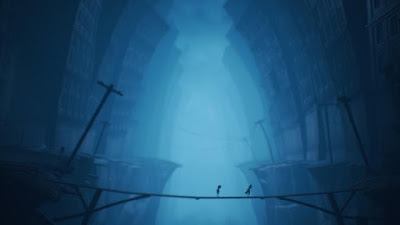After the release of Little Nightmares in 2017 and its Secrets of the Maw DLC, a follow-up game, Little Nightmares II, was announced in 2019. Having played the original game and its DLC, I was curious to see what direction the game would take, especially since it introduces a new playable character. After playing a demo for the game on PC, since that was the only platform I was aware I could play it on, I was intrigued even further and pre-ordered the game when I could. While short, I found Little Nightmares II to be an overall improvement over the original in terms of gameplay with some interesting ideas of its own, though the otherwise compelling story gets a little hazy towards the end.
Following a dream involving a door at the end of a seemingly-endless hallway, a boy named Mono wakes up in front of a TV within a forest. While exploring his surroundings, he comes across a house where he meets Six. Soon after gaining her trust, the two of them encounter a Hunter who relentlessly pursues them. Following this, the two escape and sail across an ocean, landing at the beach of the Pale City, a city falling apart and filled with an overabundance of TVs.
 |
| Mono wakes up in a forest. |
Like the previous game, the story is told entirely through in-game visuals, as there is no voice acting to speak of and sparse cinematics that don’t leave the 2.5D perspective. Over the course of the game, it becomes apparent that TV is important to the story, with a heavy focus later on on the overconsumption of TV in a similar fashion to the first game’s focus on gluttony. Mono’s story is interesting in itself, and the ending makes everything fit together well, though, without going into detail, some story points are a little questionable.
Much of the gameplay similar to the original Little Nightmares, though it is also expanded upon in some areas. In addition to the puzzle-based gameplay, you can now wield various melee weapons such as an axe or a pipe to break down some doors and fight back against smaller enemies, though the timing of the swing takes some getting used to. Additionally, sliding is integrated more into the game, though at first it can be easy to forget that you can perform this action. In teaming up with Six, Mono can call for her attention or hold her hand to help them stay together. There are also some collectibles in the form of hats for Mono to wear, as well as hidden Glitched Memories, collecting all of which unlocks a secret ending.
Between the game’s five Chapters, each one has a unique mechanic that helps them feel more distinct. One section in Chapter 1, for instance, allows you to breath underwater to evade the Hunter, but Mono can only hold his breath for so long before going up for air. Chapter 3 sees more extensive use of the flashlight, including making it a mechanic for getting past a unique enemy type in a similar fashion to Red Light Green Light, while Chapter 4 makes more extensive use of TVs for puzzle solving.
The visual style is consistent between installments, though the graphical quality in Little Nightmares II is improved over the original game. In contrast to the Maw, there are a lot more outdoor environments in this game, allowing for more varied environments that each feature a realistic level of detail. Much of the game takes place within the Pale City, both inside buildings and within alleyways and desolate streets, though Chapter 1 takes place entirely within a forest, which, combined with the game’s 2.5D style, made me think of Inside and Limbo at times.
 |
| The Pale City has a haunting atmosphere. |
The music and sound design are also consistent with the original game, though the setting is taken advantage of to include more ambient noises whenever the player is outside. This, combined with the art direction, creates a suitably tense and unnerving atmosphere that may leave you guessing what will happen next around every corner. It’s also worth noting that Mono has some minor voice acting; though it doesn’t extend much beyond his calling out to Six or his screaming upon falling to his death, it’s enough to give him some amount of character in contrast to Six.
Little Nightmares II takes what worked about the original Little Nightmares and builds upon the potential of its world and mechanics in an interesting way. Fans of the original Little Nightmares will enjoy this game, as will those looking for more suspense-based horror titles, provided they are familiar with the original game.


No comments:
Post a Comment